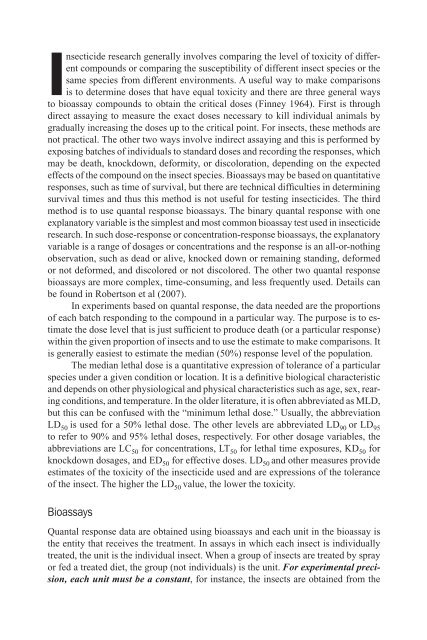Research Methods in Toxicology and Insecticide Resistance ...
Research Methods in Toxicology and Insecticide Resistance ...
Research Methods in Toxicology and Insecticide Resistance ...
You also want an ePaper? Increase the reach of your titles
YUMPU automatically turns print PDFs into web optimized ePapers that Google loves.
<strong>Insecticide</strong> research generally <strong>in</strong>volves compar<strong>in</strong>g the level of toxicity of different<br />
compounds or compar<strong>in</strong>g the susceptibility of different <strong>in</strong>sect species or the<br />
same species from different environments. A useful way to make comparisons<br />
is to determ<strong>in</strong>e doses that have equal toxicity <strong>and</strong> there are three general ways<br />
to bioassay compounds to obta<strong>in</strong> the critical doses (F<strong>in</strong>ney 1964). First is through<br />
direct assay<strong>in</strong>g to measure the exact doses necessary to kill <strong>in</strong>dividual animals by<br />
gradually <strong>in</strong>creas<strong>in</strong>g the doses up to the critical po<strong>in</strong>t. For <strong>in</strong>sects, these methods are<br />
not practical. The other two ways <strong>in</strong>volve <strong>in</strong>direct assay<strong>in</strong>g <strong>and</strong> this is performed by<br />
expos<strong>in</strong>g batches of <strong>in</strong>dividuals to st<strong>and</strong>ard doses <strong>and</strong> record<strong>in</strong>g the responses, which<br />
may be death, knockdown, deformity, or discoloration, depend<strong>in</strong>g on the expected<br />
effects of the compound on the <strong>in</strong>sect species. Bioassays may be based on quantitative<br />
responses, such as time of survival, but there are technical diffi culties <strong>in</strong> determ<strong>in</strong><strong>in</strong>g<br />
survival times <strong>and</strong> thus this method is not useful for test<strong>in</strong>g <strong>in</strong>secticides. The third<br />
method is to use quantal response bioassays. The b<strong>in</strong>ary quantal response with one<br />
explanatory variable is the simplest <strong>and</strong> most common bioassay test used <strong>in</strong> <strong>in</strong>secticide<br />
research. In such dose-response or concentration-response bioassays, the explanatory<br />
variable is a range of dosages or concentrations <strong>and</strong> the response is an all-or-noth<strong>in</strong>g<br />
observation, such as dead or alive, knocked down or rema<strong>in</strong><strong>in</strong>g st<strong>and</strong><strong>in</strong>g, deformed<br />
or not deformed, <strong>and</strong> discolored or not discolored. The other two quantal response<br />
bioassays are more complex, time-consum<strong>in</strong>g, <strong>and</strong> less frequently used. Details can<br />
be found <strong>in</strong> Robertson et al (2007).<br />
In experiments based on quantal response, the data needed are the proportions<br />
of each batch respond<strong>in</strong>g to the compound <strong>in</strong> a particular way. The purpose is to estimate<br />
the dose level that is just suffi cient to produce death (or a particular response)<br />
with<strong>in</strong> the given proportion of <strong>in</strong>sects <strong>and</strong> to use the estimate to make comparisons. It<br />
is generally easiest to estimate the median (50%) response level of the population.<br />
The median lethal dose is a quantitative expression of tolerance of a particular<br />
species under a given condition or location. It is a defi nitive biological characteristic<br />
<strong>and</strong> depends on other physiological <strong>and</strong> physical characteristics such as age, sex, rear<strong>in</strong>g<br />
conditions, <strong>and</strong> temperature. In the older literature, it is often abbreviated as MLD,<br />
but this can be confused with the “m<strong>in</strong>imum lethal dose.” Usually, the abbreviation<br />
LD 50 is used for a 50% lethal dose. The other levels are abbreviated LD 90 or LD 95<br />
to refer to 90% <strong>and</strong> 95% lethal doses, respectively. For other dosage variables, the<br />
abbreviations are LC 50 for concentrations, LT 50 for lethal time exposures, KD 50 for<br />
knockdown dosages, <strong>and</strong> ED 50 for effective doses. LD 50 <strong>and</strong> other measures provide<br />
estimates of the toxicity of the <strong>in</strong>secticide used <strong>and</strong> are expressions of the tolerance<br />
of the <strong>in</strong>sect. The higher the LD 50 value, the lower the toxicity.<br />
Bioassays<br />
Quantal response data are obta<strong>in</strong>ed us<strong>in</strong>g bioassays <strong>and</strong> each unit <strong>in</strong> the bioassay is<br />
the entity that receives the treatment. In assays <strong>in</strong> which each <strong>in</strong>sect is <strong>in</strong>dividually<br />
treated, the unit is the <strong>in</strong>dividual <strong>in</strong>sect. When a group of <strong>in</strong>sects are treated by spray<br />
or fed a treated diet, the group (not <strong>in</strong>dividuals) is the unit. For experimental precision,<br />
each unit must be a constant, for <strong>in</strong>stance, the <strong>in</strong>sects are obta<strong>in</strong>ed from the<br />
<strong>Research</strong> methods <strong>in</strong> toxicology <strong>and</strong> <strong>in</strong>secticide resistance monitor<strong>in</strong>g of rice planthoppers 39

















